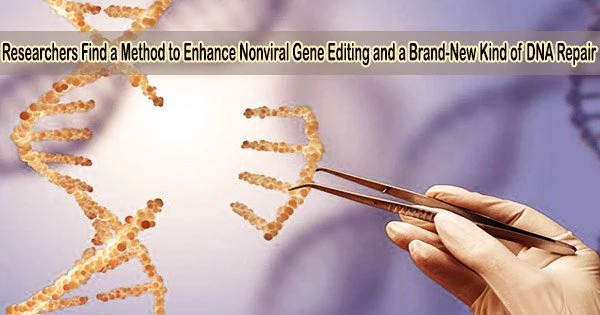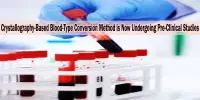A potent tool for both research and medicine, gene editing. Since the invention of the Nobel Prize-winning CRISPR/Cas9 technology, a speedy and precise tool for genome editing revealed in 2012, researchers have been attempting to expand its capabilities.
Researchers in the lab of UC Santa Barbara biologist Chris Richardson have developed a technique that boosts the effectiveness of CRISPR/Cas9 editing without the usage of viral material to deliver the genetic template used to change the target genomic sequence.
According to their new paper published in the journal Nature Biotechnology, their method stimulates homology-directed repair (a step in the gene editing process) by approximately threefold “without increasing mutation frequencies or altering end-joining repair outcomes.”
“We’ve found a chemical modification that improves non-viral gene editing and also discovered an intriguing new type of DNA repair,” Richardson said.
Find, cut and paste
The CRISPR/Cas9 technology relies on a defense mechanism used by bacteria to fend off viral assaults. In order to do this, the bacteria take a bit of the genetic material from the invasive virus and incorporate it into their own to recognize it later. If the bacteria become infected again, they can destroy the now-familiar genetic sequences.
With the aid of the CRISPR system, the Cas9 enzyme is used as molecular “scissors” in gene editing to cut regions it recognizes. This cut also offers a chance to use the cell’s inherent repair processes to replace the severed genes with comparable but superior ones. If successful, the cell’s expressions and subsequent functions should be altered.
What we think happens is that the cell detects and tries to repair the damaged DNA that we’ve added this crosslink to. And in doing so, it delays the cell past a checkpoint where it would normally stop this recombination process. And so by prolonging the amount of time that it takes the cell to do this recombination, it makes it more likely that the edits will go to completion.
Chris Richardson
To deliver the repair template DNA to the nucleus of the cell where its genetic material lives, oftentimes viruses are used. While they are effective, the researchers say, viral workflows “are expensive, difficult to scale and potentially toxic to cells.”
Nonviral templates may be more affordable and scalable, though researchers still need to get beyond toxicity and efficiency obstacles. The Richardson Lab discovered in their investigation that adding interstrand crosslinks to the workflow significantly enhanced homology-directed repair.
“Every workflow that we have put this approach into has worked better by roughly threefold,” Richardson said.
Interstrand crosslinks are lesions that prevent DNA helix double strands from replicating by keeping them bound to one another. This process is used in cancer chemotherapy to stop the growth of tumors and eradicate cancer cells. However, it was discovered that these crosslinks stimulated the cell’s inherent repair mechanisms and increased the likelihood of editing success when added to a homology-directed repair template.
“Basically, what we’ve done is taken this template DNA and damaged it,” Richardson said. “We’ve in fact damaged it in the most severe way I can think of. And the cell doesn’t say, ‘Hey this is junk; let me throw it away.’ What the cell actually says is, ‘Hey this looks great; let me stick it into my genome.’” The result is a highly efficient and minimally error-prone nonviral system of gene editing.
Like many scientific discoveries, theirs was also a result of a happy accident. Hannah Ghasemi, a graduate student researcher and the lead author, noticed unexpected alterations to the results of their tests while working to extract proteins to study DNA repair.
“We were introducing these chemical modifications to the DNA templates in order to be able to pull them out of the cells and see what proteins were bound to them, and I was just checking to see if this modification had somehow affected the editing in any capacity,” she said. “I was expecting to either see no change or that it actually might have negatively affected the editing.”
Instead, she discovered a beneficial effect, with the editing activity of the crosslinked controls being up to three times higher. Additionally, the scientists discovered that the frequency of mutations remained same despite an increase in edits and, thus, the likelihood of errors. They still have questions about the precise processes that led to this outcome, but they have some theories.
“What we think happens is that the cell detects and tries to repair the damaged DNA that we’ve added this crosslink to,” Richardson said. “And in doing so, it delays the cell past a checkpoint where it would normally stop this recombination process. And so by prolonging the amount of time that it takes the cell to do this recombination, it makes it more likely that the edits will go to completion.”
“Studying this new process could also lead to a better understanding about how cells detect editing reagents and how they ‘decide’ to accept them or not,” he said.
According to the team, this technique will be particularly useful in ex-vivo gene editing applications, which includes preclinical and disease research.
“We can more effectively knock down genes and insert things into genomes to study systems outside of the human body in a lab setting,” Ghasemi said. “This development allows them to more efficiently build disease models and test hypotheses about how diseases work, which could lead to better clinical and therapeutic approaches.”
















